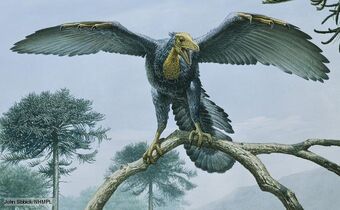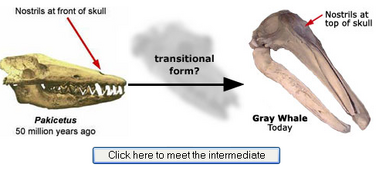What are Intermediate Species?[]

The Urvogel Archeopeteryx lived around 150 million years ago and represents the transition between reptiles and birds (BBC, 2013).
These are specific species that create “connecting links” (Kutschera & Ni, 2004) between the fossil record of life which help to demonstrate the gradual process of speciatin. (Berkeley, n.d.).
Importance of Intermediate Species[]
Genomic and morphological transformations that have created the biodiversity we now experience have been preserved in stages of evolution in these intermediate specie fossils. Intermediate species are essential evidence in the case for evolution because without them, it cannot be proved that all organisms on Earth stemmed from one common ancestral life form.
Dilemmas[]
Are a human?

Photo provided by: http://evolution.berkeley.edu/evolibrary/article/lines_03
Examples:
- · Amphibian/land vertebrate (Pederpes)- Intermediate form between primary aquatic Upper Devonian amphibians and early tetrapods
· Reptile/mammal (Thrinaxodon)-Mammal-like reptiles that show a blend of mammalian and reptilian characteristics
· Terrestrial reptile/ichthyosaur (Utatsusaurus)-Intermediate form of extinct marine reptile that shows features between ancestral terrestrial amniotes and aquatic ichthyosaurs
· Dinosaur/bird (Microraptor)-Intermediate species between flightless primitative birds, it had four winged-like structures that allowed it to glide
· Lizard/snake (Pachyrhachis)—Intermediate form of snakes and an extinct lizard-like reptile. It was a primitive snake with limbs.
· Land mammal/seacow (Pezosiren)--Intermediate form of a primitive seacow with both terrestrial and aquatic adaptations.
· Hoofed land mammals/whales (Ambulocetus, Rodhocetus)---Intermediate form between amphibious and terrestrial even-toed ungulates and aquatic whales
· Ancestor of chimpanzees/modern humans (Sahelanthropus)---The most basal ape-like African hominid. Mosaic of primitive (chimpanzee-like) and derived hominid features. (Kutschera & Niklas, 2004)
References[]
Kutschera, U. & Niklas, K. (2004). The modern theory of biological evolution: an expanded synthesis. Naturwissenschaften 91:255–276
BBC Nature. (2013). Archaeopteryx, Prehistoric Life. Retrieved from: http://www.bbc.co.uk/nature/life/Archaeopteryx.
Berkeley. (n.d). Transitional Species-Understanding Evolution. Retrieved from: http://evolution.berkeley.edu/.